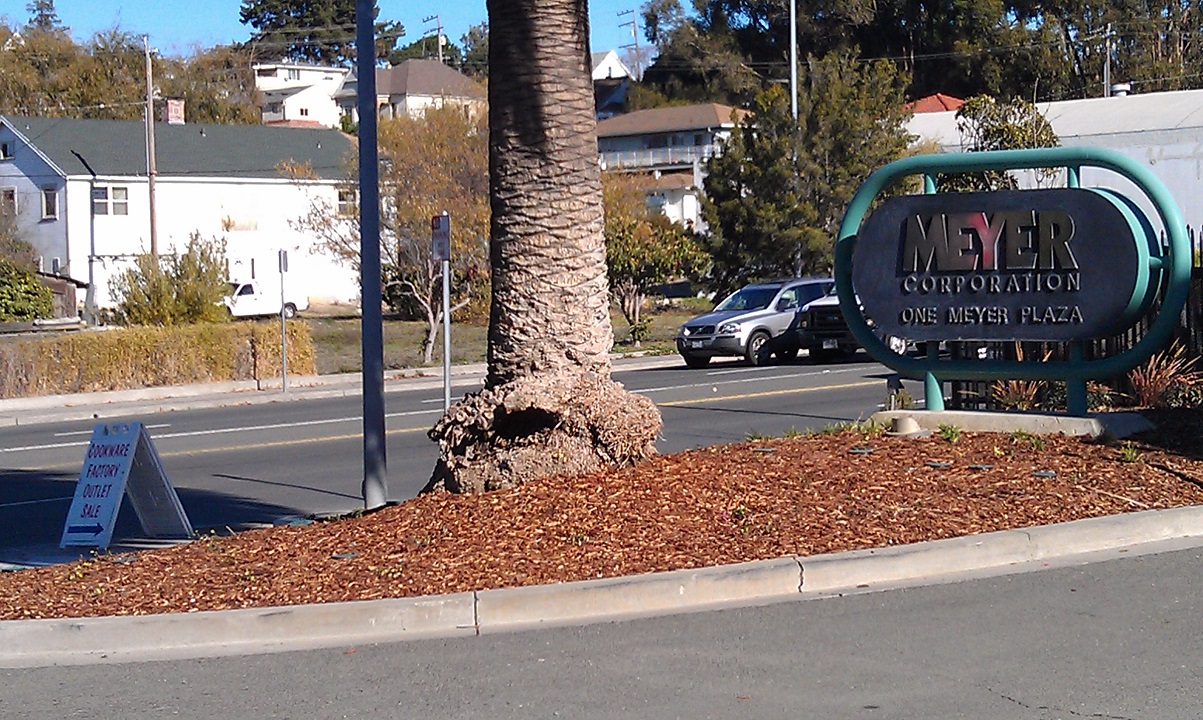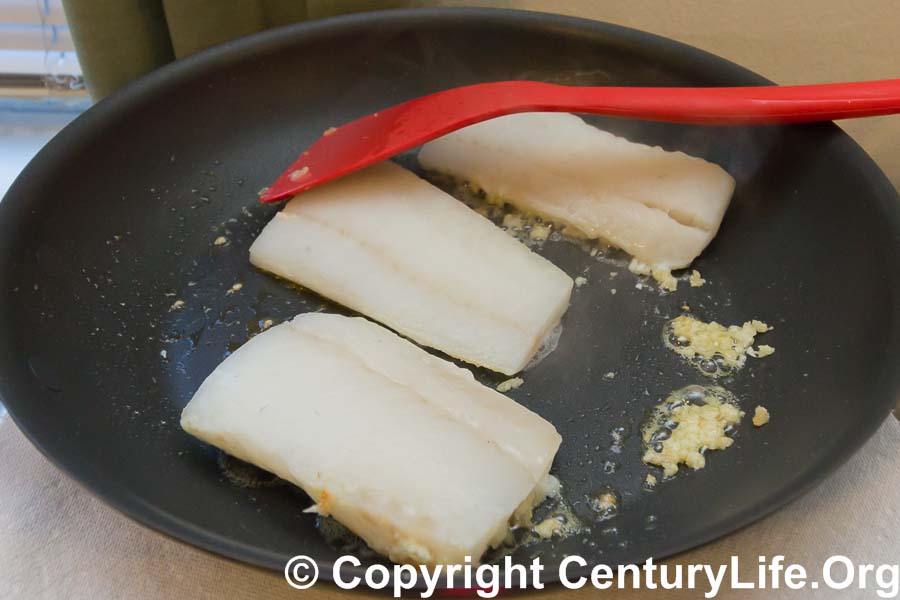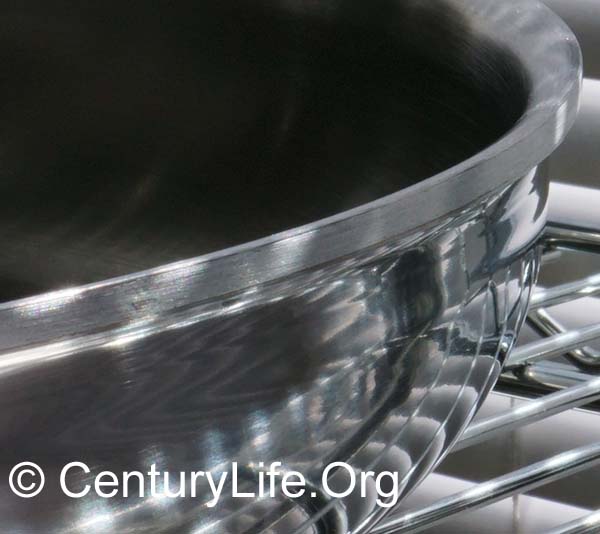THE SHORT ANSWER
For each common cookware material below, I’ll summarize their strengths, weaknesses, and offer a quick summary.
| Material | Strengths | Weaknesses | Summary |
| Aluminum | Cheap, Best heat spreading power per pound (a thick aluminum layer can spread heat quite evenly) | Easily bends and scratches, chemically reactive, not dishwasher or induction compatible | Cookware makers usually coat aluminum with PTFE (such as Teflon) or stainless steel because bare aluminum is chemically reactive and can give metallic off-tastes to food, particularly acidic foods like tomatoes and citrus. Stainless also makes it dishwasher/induction compatible and more resistant to bending. Anodized aluminum is a thin layer of hard aluminum “rust” that can chip/flake off over time and does not provide the structural support or dishwasher/induction compatibility that stainless provides. But anodization that hasn’t chipped off yet makes it relatively chemically inert and resistant to scratches. |
| Carbon Steel | Thinner, lighter, more expensive alternative to cast iron | Uneven heating, chemically reactive, rusts, stays hot and takes more care (keep away from small children and pets) | Basically a thinner, lighter version of cast iron with similar drawbacks like weight, chemical reactivity, and sensitivity to rust. New carbon steel pans are usually smoother than new cast iron pans, so carbon steel requires less seasoning to make semi-nonstick. |
| Cast Iron | Most cast iron is produced thick (3.5 mm or more) and thus holds a lot of heat. Thus cast iron is slow to heat up and slow to cool down. Can be seasoned to create a semi-nonstick surface. | Uneven heating, chemically reactive, rusts, stays hot and takes more care (keep away from small children and pets) | Cast iron rusts if not cleaned and stored and seasoned properly. Seasoning means burning oil onto the pan to produce a semi-nonstick, plasticky film that also prevents the iron from rusting. Modern cast iron is bumpy and requires lots of seasoning to make it semi-nonstick. Although the seasoning produces far less pollution than manufacturing PTFEs like Teflon, there aren’t lots of studies on the long-term effects of ingesting small amounts of seasoning each meal, though presumably your body’s natural defenses can handle it. Cast iron is chemically reactive (even through layers of seasoning) and can create metallic off-tastes/off-colors, so avoid cooking acidic foods like tomatoes in bare cast iron. Enamel-coated cast iron gets around the reactivity problem, but enamel can chip off and often costs more. |
| Copper | The best common cookware material in terms of spreading heat quickly and evenly. | Expensive and heavy. Higher upkeep than stainless, not dishwasher or induction compatible. Bare copper is chemically reactive and creates toxic compounds, so copper cookware must be lined with something nontoxic like tin or steel. | Millimeter for millimeter, copper delivers the fastest and most even heat spreading power of all common cookware materials (silver is slightly better but is softer and cost-prohibitive). Copper is also heavy and stores almost as much heat per millimeter as cast iron. Bare copper changes color when exposed to heat and eventually turns into a dull, matte brownish-black if not polished. Copper is harder than aluminum and not as easily bonded to stainless, so “clad” copper designs (copper coated with stainless steel) usually have very thin layers of copper, to the point where you’re probably better off with thicker aluminum pans coated with stainless, instead. (NOTE: Copper is toxic when ingested in large quantities which is why it is usually layered with tin or stainless steel to prevent its direct contact with fod. But for certain applications like whisking eggs or jam, bare copper is okay. Where one runs into bigger problems is cooking anything acidic in bare copper.) |
| Glass | Transparent, chemically nonreactive | TERRIBLE thermal conductivity, fragile. | Avoid cookware made purely out of glass/enamel/ceramic for the stovetop. An oven with gentle, even air heating is fine, but stoves deliver highly concentrated heat which will lead to hotspots if the material can’t spread the heat around fast enough. If the cookware has a layer of heat-conductive material like cast iron, carbon steel, aluminum, or copper, and is merely coated with glass/enamel/ceramic, that’s fine. |
| Stainless Steel | Resists dents and bending, chemically less reactive | Very bad thermal conductivity | Stainless steel resists bending and dents and has no possibility of chipping/fracturing like enamel/glass/ceramic if you accidentally bang it into the side of the sink or drop it. Stainless is also relatively chemically nonreactive, unlike carbon steel or cast iron or copper or aluminum. However, stainless by itself is a poor thermal conductor, so you almost always want to buy stainless steel bonded with a better heat conductor like aluminum or copper; the heat conductor does the job of spreading heat around evenly, and the stainless steel provides a chemically less-reactive cooking surface. |
| Tin | Used as a relatively inexpensive cooking surface on copper | Fragile, low melting point, re-tinning gets expensive | Copper’s toxicity is usually addressed in one of two ways: bonding stainless steel as a nonreactive cooking surface (expensive but long-lasting), or coating the copper with tin (inexpensive up front but costly long-term to hire someone to re-tin the cookware; for instance, it costs about $100 including shipping and insurance to re-tin a 28cm-diameter frying pan, though some people live close to re-tinners and don’t have to pay shipping/insurance). Tin is a little less sticky than stainless but is very soft. Even if you don’t use metal utensils or nylon scrubbies on tin, and even if you take great care to avoid cooking anything with bones in it (since meat/fish bones can scratch tin), tin wears away eventually and must be re-applied. Lastly, tin melts at about 450F (230C), and it takes only one accident to melt off enough tin to render a pan unusable. Tin is only for households where everybody has a perfect or near-perfect record of never overheating pans. |
| PTFE (Teflon) | Relatively inexpensive, easy to clean | Wears off with use, breaks down when overheated, creates pollution, and emits trace amounts of PFOA into your body | PTFE like Teflon is chemically inert (will not react to food, so it’s a popular coating for aluminum, which is very chemically reactive). PTFE is very slippery and easy to clean. However, PTFE is fragile and will eventually wear off with use, especially if you use metal utensils or stiffer nylon scrubbies on it. PTFE begins to break down and emit potentially toxic gases at about 400F depending on exact formulation, with the breakdown accelerating as temperatures increase. Bonding PTFE to cookware emits PFOA pollution which is toxic and takes decades to break down in the environment. There is almost no PFOA left in the cookware, but if you do cook on PTFE nonstick pans, you may eventually ingest very small amounts of PFOA. The amounts are small enough by themselves to not pose a health risk according to US government standards, but PFOA stays in your body for a very long time. |
Back to How to Choose Cookware.
THE LONG ANSWER
If you want to know more about the common cookware materials, please see their respective information pages below:
- Aluminum
- Carbon Steel
- Cast Iron
- Copper (Cuivre)
- Enamel/Glass/Ceramic
- Silver
- Stainless Steel (Inox)
- Tin
- PTFE (e.g., Teflon)
If that’s not enough for you, then also see Thermal Properties of Metals. You may also want to see the electric and gas even heating rankings.
Back to How to Choose Cookware.


